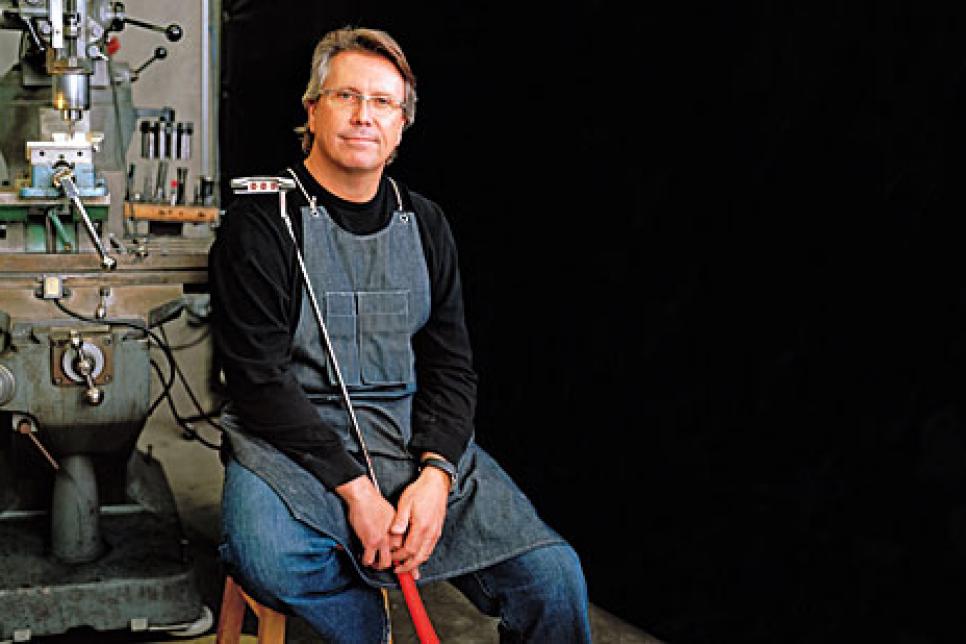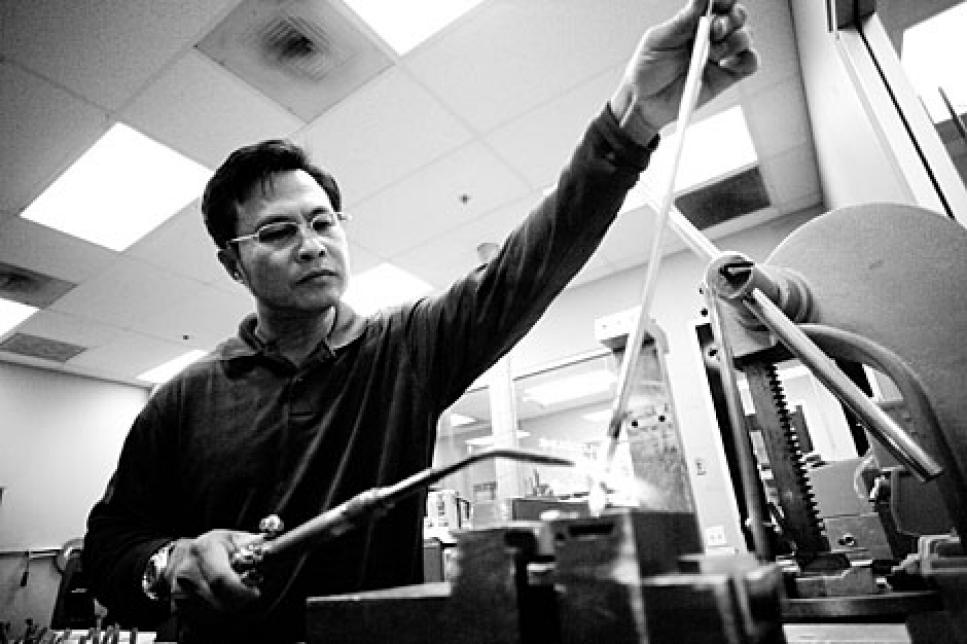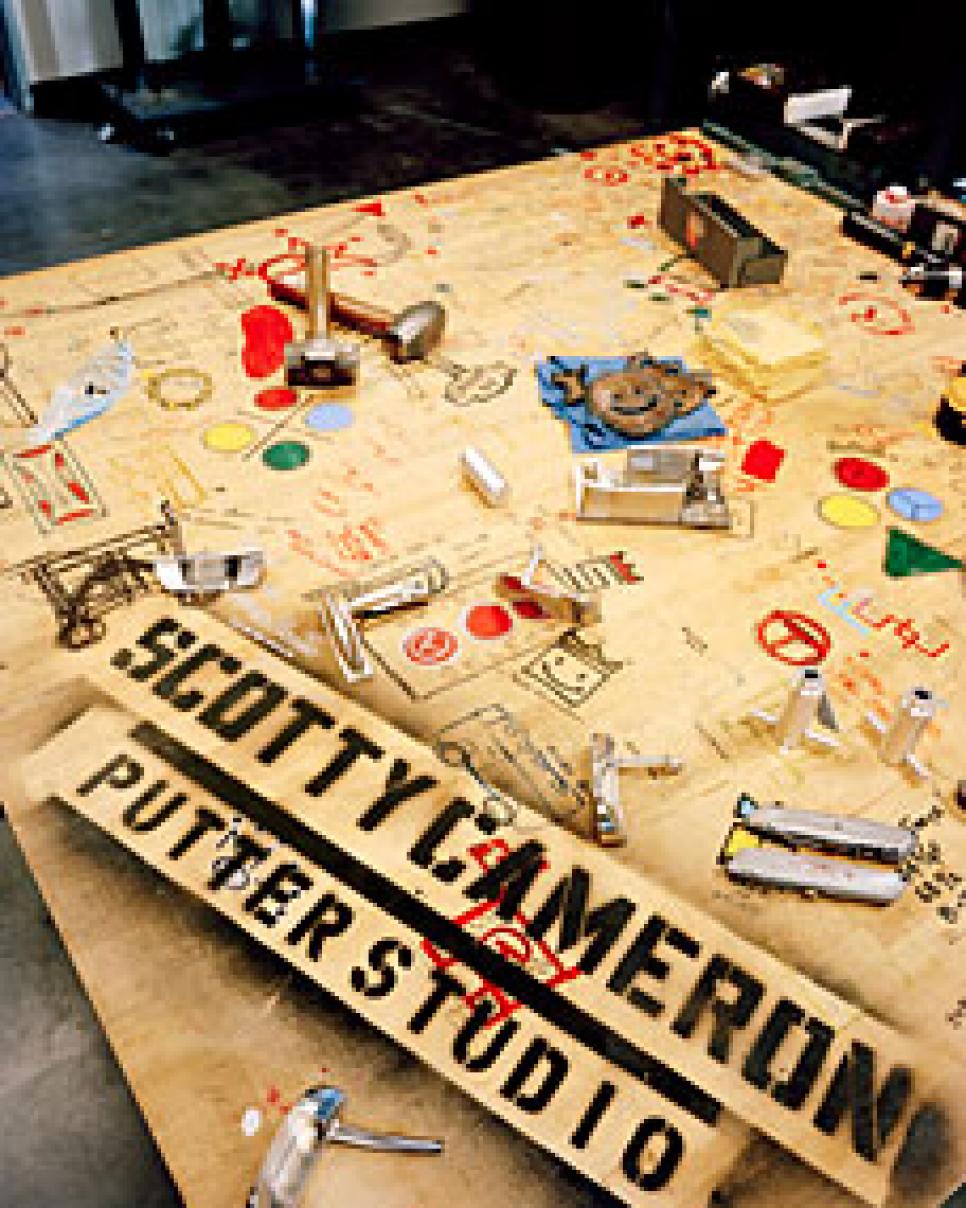News
Chasing Scotty Cameron

craftsman: Cameron designs his putters at a studio in San Marcos, Calif., where tour pros come for high-tech custom fittings.
The name might sound thought up by a corporation, the Betty Crocker of putters, but Scotty Cameron is in fact a real breathing human. Every morning, the boyish 46-year-old wakes to put on expensive wireframe specs and chooses one of his vintage cars to make the short commute to his hi-tech studio in San Marcos, Calif. There he fires up a milling machine and proceeds to sculpt the objects drooled over by golfers around the world. Tiger Woods has sworn by the same Cameron model for all his 14 majors.
"I don't know a single serious player who hasn't putted with a Cameron at some point in his life," says David Eger, a two-time winner on the Champions Tour. There are other men who make putters, but their existences pale by comparison so much it's as if they're in a different line of work. Original millings by the Cameron hand (not the stock models purchased by you and me for $300) have fetched prices as high as $30,000 at auction. He has become to putters what Les Paul is to electric guitars. There is even a museum dedicated to him in Japan, complete with the paint-splattered worktable and tools the boy genius used in his formative years.
Vincent Van Gogh sold only one painting in his lifetime and died 83 years before he, or anyone for that matter, could visit the Van Gogh Museum in Amsterdam. Online auctions run by the Scotty museum regularly return bids of more than $1,300—for a headcover.
"Most of the tour guys in the late-'70s and early-'80s used factory stock Ping putters," says Clay Long, designer of the oversize MacGregor Response putter Jack Nicklaus used in his victory at the 1986 Masters. "As obvious as it might seem today, the notion of fine-tuning the specifications to the player, massaging the look to fit his eye, wasn't until later. Scotty was essentially the first to go out on tour successfully and say to pros, 'Let me make a putter just for you.' "
At least first in the era of modern milling machines. Puttermaker David Mills, who carries on the legacy of his father, T.P., recalls, "Back in the 1960s players would come over to my dad's shop, which was in our home, and he'd look at their stroke and build them a putter by hand. They'd pay cash or by check. My dad never gave putters away. It wasn't ego. He needed the money."
With the exception of the odd-looking mallet, say a Futura or a Detour, a cynic would contend most Cameron shapes are unoriginal, merely elegant versions of T.P. Mills blades or the first Ping Ansers by Karsten Solheim.
"Scotty Camera" is the derisive nickname sometimes whispered by rival designers.
But almost every designer makes a putter that mimics the Anser. Will any of them ever be big enough to truly classify as a rival?
One man who was big enough, at least once, is Bobby Grace. Nick Price used Grace's high-MOI "The Fat Lady Swings" mallet to capture the 1994 PGA Championship. Annika Sorenstam used Grace's "Pip-Squeak" to win her first seven pro events. As TV cameras zoomed in on the final rolls of those victories, the puttermaker from Florida who never graduated from high school shared in the glory. For puttermakers, purchase orders always spike the day after someone wins using one of their designs.
"The small guy is only going to get known through use on the tour," Grace says of aspiring designers. "But it's not like it was when I got started. Now the PGA Tour has stonewalled this guy by making the guideline for credentials a catch-22. It's impossible to get a credential to hang out by the putting green to get tour players to try your putter. You can only get a credential if a player is already using your product."
Because dreamers are thwarted from loitering on golf's grandest stage—in part to protect player privacy —the pros who have played David Whitlam putters have names such as Dae-Sub Kim, Sung-Hyun An and Bae-Kyu Tae. "As much as I'd like to get out on the PGA Tour again," says Whitlam, "I'm happy right now with my Korean Tour players. They're young, and they're a lot of fun." If instigated, Whitlam is full of crazy stories of nights out until sunrise in faraway Asian cities.
Set down a David Whitlam Signature Series next to a Scotty Cameron Studio Style and you see two shiny Anser-styles milled from high-grade stainless steel that sit dead square. Save the aficionado, it is similar to trying to tell the difference between twins. Yet Whitlam could be described as the anti-Cameron. The Canadian turned Californian plays golf in sunglasses, an untucked shirt, cargo shorts and prefers carts to caddies. He makes no pretensions about being an artist. He's more of a jeweler.

"My putters are for people who like having nice things," Whitlam says. "A putter is a flat surface with a few degrees of loft and an attention to weighting. A Timex can tell the time as good as a Rolex, but which would you rather have?"
Whitlam says he sells about 14,000 putters each year. Weaving in and out of four lanes of So-Cal I-5 traffic at 85 miles per hour in his Chevy Suburban with flashy aftermarket rims, talking on a cell phone, Whitlam comes across as a high roller. But you wonder how secure his slice of the putter pie actually is. He is heading to Mario's, a finishing shop in a nondescript commercial lot, and it is here you see he is a shrewd businessman with eyes on the margins.
It's dusty and crowded and ripping with metallic noise. Piled at the main door are cardboard boxes spilling with raw steel heads. About a dozen men, mostly Hispanic, are operating grinding belts and bead blasters and affixing grips, while three steady-handed women apply colored paint into tiny sole engravings. Whitlam knows the employees by name and jokes with each one as he goes around checking their work. Guerin Rife of Rife putters is also in the room, standing at a work table sorting a batch of heads. Along with Whitlam and Rife, companies such as SeeMore, Bettinardi and Sizemore also ship milled heads to Mario's for finishing touches. "It's one of the best, most trusted shops around," says Whitlam. At its maximum Mario's can process 1,500 putters a week.
The person best positioned to supplant Cameron as putter king was working at a finishing shop similar to
Mario's for $4 a hour the first time he touched a golf club. Kia Ma, who now customizes putters for TaylorMade's staff of 179 tour professionals, emigrated to the U.S. from Vietnam in 1980 when he was 26.
When you meet Kia, he shakes your hand and bows slowly. But when he moves around his shop at TaylorMade headquarters rifling through cabinets, he barks orders as if there wasn't a spare second. One moment he is fiddling with a face insert, but blink, now he's in the corner securing a head in a vice and igniting a blowtorch with a Bic, sans goggles or gloves. Once the hosel is glowing orange, Kia fits a female bending rod over it and pulls slightly in one direction to decrease the lie angle, then slightly in another to increase the offset. Before the hosel has cooled completely, Kia grabs the next form off a pile on his worktable. It has the heading "Mike Weir," and a chart of specifications with a headache of digits, and a scrawled note about changing the alignment aid.
Kia picks up three overstuffed manila folders of these forms to demonstrate their weight. "These are the best golfers in the world," he says, and takes a long unblinking pause to impress upon you the seriousness of his job. "I cannot be late."
Says Nick Faldo of Kia, "It's a very visual process, so language has never been a problem." Kia's English is still a work in progress.
Kia Ma picks up three overstuffed manila folders and says: "These are the best golfers in the world. I cannot be late."
For all the years of grunt work in the shadows, Kia, 54, is only now getting to stamp his name on putters. TaylorMade has just introduced the Rossa TP by Kia Ma line to the general market. Could it be the company sees star potential in Kia as its man to finally rival Titleist?
Golf was not part of Kia's early story. "In Vietnam I was boat mechanic," he says. "I can redo a whole engine." It was also through these skills that Kia, as well as several people from his village, were able to escape their war-torn country in the first place. On a boat whose hauling purpose and capacity was 3,000 bags of rice, Kia captained the one-way refugee trip to Malaysia. He lived there, and then in Indonesia, before eventually coming to the U.S.
If a good reputation with tour players and the marketing backing of one of the biggest companies in golf is what's positioning Kia Ma to chase Cameron, Kevin Burns is relying solely on himself.
KB Golf, which designed the putter José Maria Olazábal used to win the 1999 Masters, once had 20 employees. But now the workforce is just the boss. "People were just showing up for the paycheck," Burns says. "I'd find all these mistakes and chatter marks and end up having to scrap a bunch of heads. I'm an artist. If a putter is going to have my name on it, it has to be perfect."
When you first walk into the KB Golf warehouse in San Jose, you can't find anyone. An industrial contraption the size of 20 refrigerators occupies half the floor space. An empty forklift is parked in the corner next to two barrels of metal shavings. The only sound is of a man talking agitatedly to someone who isn't getting any words in. Where is Burns?
You find him in the belly of the contraption, cell phone propped between his shoulder and ear, both hands investigating the controls as he continues talking down to whomever is on the end of the line.
"I paid them $650,000 for this machine," Burns huffs after hanging up. "You'd think they could send a guy down here to check it out." He then launches into a detailed physical explanation of why certain mathematical accuracy standards are necessary when machining multiple heads from raw blocks of steel on five-axes with the touch of a button. It's very complicated.
"People think I've gone into the dark," Burns says, "But this thing I've been working on could turn out to be huge."
"This thing" is what Burns calls "mass-customization." Once up and running, the giant Mazak 650 milling machine automatically will accept orders from electronic Kevin Burns fitting kiosks in retail shops. By gripping the telescopic grip of the kiosk, a customer's length and lie specifications are recorded, allowing them to choose alignment and head-shape options from a screen, and even order their name engraved in any color. The putter will arrive in the mail two weeks later. "I want Joe Consumer to feel he's got something that's just as good as the guy on TV has," Burns says. "That the putter has been finished and fit just for him. And not bent or welded—that destroys the metal. I mean specifically machined."
Burns doesn't draw on napkins. To explain his creative process, he boots up an engineering program. Equal to the ambition of inventing new head shapes is programming the machine to cut metal blocks in the correct sequence to achieve them. A seemingly simple tweak, such as rounding the area of the neck underneath the shelf of the hosel, can pose terrible complications.
Burns looks at the dead machine. "Every day I'm down costs me a thousand dollars."
The phone rings. He fishes it quickly from the pocket of his track pants and answers cordially. The downward shift of his moustache indicates it's the service technician again, who doesn't have an answer.

Cameron was once on his own, too. Fortunately, his start coincided with the economic boom in Japan. In the 1980s, at a shop in Honolulu called A Piece of Time, Cameron sold custom putters, often inlaid with diamonds, for as much as $50,000, mainly to Japanese men. This netted enough capital to go out without a financial backer on the PGA Tour, where Cameron promptly got a dozen players using his putters. He got his first PGA Tour win in 1992 and then his first major with Bernhard Langer at the 1993 Masters. Mizuno approached Cameron to design a commercial line, which he did in 1992 and 1993. Then, in September 1994, Titleist approached him. The following year Wally Uihlein, CEO of Acushnet, commissioned the building of the Putting Studio in San Marcos, an expansive fantasy workshop of lasers and cameras that run at 1,000 frames a second for Cameron to explore the most basic, yet most maddening, shot in golf.
"Back when nobody could afford it, Wally said 'OK,' " Cameron remembers, gratefully. "It was a place to bring tour players and show them the facts nobody knew. Should the face be square to the putter arc or the line of the putt? What is the proper loft? Does the ball roll at impact? Which putter shape is going to get them to line up square every time? The Studio let us answer all these questions, and players were able to leave with confidence."
"People pick up a Cameron putter and they don't know why they like it so much," says the maker himself. "I've learned to make the trailing edge of a putter very soft in shape. Roly-poly edges. Golfers feel nerves, tension when they putt. I believe you can make a putter soothing to take out that tension."
Cameron's puttermaking began long before he was a clubhouse name. "My father and I used to go to the tire store to get lead from old rims," he says. "We'd heat the lead in a coffee can and then mill our own heads. We'd stick them on the ends of old 3-iron shafts. We'd go play nine holes, and then come back to our garage and manipulate what we didn't like. Putting was my weakest link in high school, so I was always tinkering."
Visit cameroncollector.com, a fan-run discussion forum, and you can glimpse the mania. An army of devotees type messages like, "Does anyone else suffer Scotty yearning, it's like a religious faith—you just believe!" or refer to a putter's aesthetics as "sex on a stick."
You don't often (ever?) hear such sycophantic waxing about the work of Kia Ma or David Whitlam. Last June a press release announced Grace's resignation from MacGregor. For legal reasons, neither party will disclose much, but Grace says he was dissatisfied with the lack of marketing firepower. The release coldly stated, "MacGregor Golf retains ownership of all trademarks and other rights associated with Bobby Grace and the name Bobby Grace." So as the company fights its own troubles, Grace has to wait to see when he can use his name again on his putters. Kevin Burns finally got the Mazak fixed, five months after we visited him.
"I feel their jealousy. I'm very lucky to be in the position I'm in. ... I just wish people would stop with the negativity." Scotty Cameron
One of Cameron's playful stampings is a crown, and it seems he will continue to wear it for a while longer.
"I feel their jealousy," says Cameron of designers who aren't him. "I'm very lucky to be in the position I'm in. T.P. Mills and Karsten Solheim opened the door for Scotty Cameron. I just wish people would stop with the negativity, and see I'm just carrying the torch for the next generation."
Cameron has been talking for more than an hour, this from someone who initially "respectfully declined" to be interviewed because his agent didn't want him featured in an article with other putter designers.
"Sorry," says Cameron. "I get talking about putters, and I just keep going."